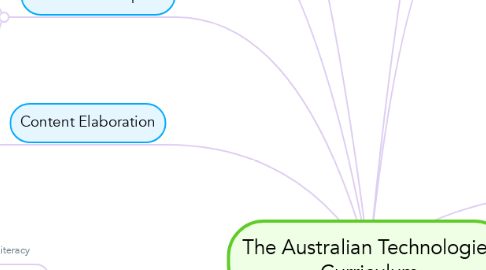
1. General Capabilities
1.1. Literacy
1.2. Numeracy
1.3. ICT Capability
1.4. Critical and Creative thinking
1.5. Personal and Social Capability
1.6. Ethical understanding
1.7. Intercultural Understanding
2. Student Diversity
2.1. Gifted or talented Students
2.1.1. Who can learn faster at some or all areas than other students
2.1.2. find, solve or act on problems on all subject areas more readily
2.1.3. manipulate abstract ideas of make connections
2.2. English as an additional language/dialect
2.2.1. overseas - or Australian-born students whose first language is a language other than english
2.2.2. Aboriginal or Torres Strait Islander students whose first language is an indigenous language
2.3. Students with a disability
2.3.1. Students who comply with the Disability Standards for Education 2005
3. Cross-Curricular Priorities
3.1. Aboriginal and Torres Strait Islander histories and cultures
3.2. Asia and Australia's engagement with Asia
3.3. Sustainability
4. Content Descriptors
4.1. provides stimulus for teachers to develop teaching and learning programmes
4.2. Provides areas of integrated learning
4.3. Is sequential from foundation to year ten
5. Content Elaboration
5.1. Content Elaborations are intended to help teachers develop a shared understanding of the content descriptors
5.2. Provided for each content description from foundation to year ten to illustrate the content
6. Band Levels
6.1. Foundation to year two
6.2. Year Three to Four
6.3. Year Five to Six
6.4. Year seven to eight
6.5. year nine to ten
7. Strands
7.1. Design and technologies
7.1.1. Knowledge and Understanding: the use, development and impact of technologies and design ideas across a range of technologies
7.1.1.1. https://dtm4260.edublogs.org/?p=2331&preview=true
7.1.2. Processes and production skills: the skills needed to create design solutions
7.2. Digital Technologies
7.2.1. Knowledge and Understanding: the information system components of data, and digital systems
7.2.2. Processes and production skills: using digital systems to create, define, design and implement information, and evaluate these solutions from existing information systems against a criteria
7.2.2.1. https://dtm4260.edublogs.org/?p=2270&preview=true
8. Curriculum Aims and Objectives
8.1. Develop confidence as critical users of technologies and designers
8.2. Investigate, generate and critique designed solutions
8.3. understand roles and responsibilities of people in design occupations, and how their designs and technologies contribute to society
8.4. Use design and thinking processes to generate design ideas - communicate to a number of audiences
8.5. produce designed solutions suitable for a range of technologies, and be able to manipulate design factors.
8.6. evaluate designed solutions and process and use knowledge on new areas of information
9. Subjects
9.1. English
9.2. Mathematics
9.3. Science
9.4. History
9.5. Geography
9.6. The Arts
9.7. Health and Physical Education
9.8. Economics and Business
10. Key Concepts
10.1. Systems and thinking
10.1.1. a holistic approache to identifying and solving problems where the focal point are treated as a system
10.1.2. Technologies requires students to understand the complexity of a systems and their interactions and interrelationships and how they influence the functions of systems
10.2. Design Thinking
10.2.1. Involves the use of strategies to understand design needs and opportunites
10.2.2. Students explore, analyse, and develop design ideas through the use of different processes such as presented data, the degree of interaction with that data and types of computational processing
10.3. Computational Thinking
10.3.1. A problem solving method which involves integrating strategies, breaking down problems, interpreting patterns and implementing algorithms
10.3.2. This type of thinking is used in technologies to understand the quantified data and solves problems which involves computations.
11. Key Ideas
11.1. Creating preferred futures
11.1.1. how solutions that are create are used in the future
11.1.2. investigate possible risks and benefits of creating solutions
11.1.3. use critical and creative thinking to weigh short and long term impacts
11.2. Project managment
11.2.1. will develop skills to manage projects to successful completion through planning, organising and effective time management
11.2.2. Plan for sustainable use of resources when managing projects and take into account ethical, health and safety considerations

